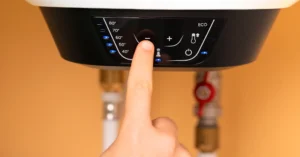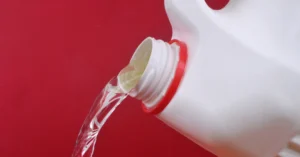Winter brings many challenges for homeowners, but one of the most expensive and frustrating problems is dealing with frozen pipes prevention. When temperatures drop below freezing, the water inside your pipes can turn to ice. This causes serious problems because frozen pipes prevention isn’t just about stopping ice – it’s about stopping expensive damage to your home.
When water freezes, it expands. This puts huge pressure on your pipes, whether they’re made of metal or plastic. Even the strongest pipes can crack or burst when this happens. The American Red Cross explains that this expanding water can cause pipes to break no matter how strong they are.
Why Do Pipes Freeze in the First Place?
Not all pipes have the same risk of freezing. Some pipes are much more likely to freeze than others. Understanding which pipes are at risk helps you focus your frozen pipes prevention efforts where they matter most.
The pipes most likely to freeze include outdoor faucets, swimming pool lines, and sprinkler systems. Inside your home, pipes in unheated areas like basements, crawl spaces, attics, and garages are at high risk. Pipes that run along outside walls with little insulation are also dangerous spots.
Even homes in warmer climates can face this problem during cold snaps. According to State Farm’s 2023 claims data, they received over 17,200 frozen pipe claims, paying out more than $432.5 million. The average claim was over $23,500 – that’s a lot of money that could be saved with proper frozen pipes prevention!
Essential Steps for Frozen Pipes Prevention
1. Disconnect and Store Outdoor Hoses
Before winter arrives, remove all garden hoses from outdoor faucets. Drain the water from these hoses and store them inside your garage or basement. A frozen hose can create pressure that travels back into your home’s plumbing system, causing damage to pipes inside your house.
After removing hoses, close the inside shut-off valves that supply water to outdoor faucets. Then open the outside faucets to let any remaining water drain out. Keep these outside valves slightly open so any water left in the pipes can expand without breaking the pipe.
2. Add Insulation to Vulnerable Areas
Proper insulation is one of the best tools for frozen pipes prevention. Add extra insulation to attics, basements, and crawl spaces. This helps maintain higher temperatures in these areas where pipes often run.
Look for pipes in unheated areas throughout your home. Check your garage and under kitchen and bathroom cabinets. Both hot and cold water pipes in these spots should be wrapped with pipe insulation materials available at hardware stores.
For pipes that are especially vulnerable, consider installing UL-listed heat tape or heat cables. These products wrap around pipes and provide gentle warmth to prevent freezing. Even something as simple as newspaper can help – just a quarter-inch of newspaper provides significant protection for pipes that don’t usually face long periods below freezing.
3. Seal Air Leaks Around Your Home
Cold air drafts can quickly freeze nearby pipes. Walk around your home and look for gaps around electrical wiring, dryer vents, and pipe entrances. Use caulking to seal these openings and keep cold air out.
Even tiny openings can let in enough cold air to freeze a pipe, especially during severe weather with strong winds. Pay special attention to pipes built within outside walls, as these are particularly vulnerable when wind-chill factors drop well below zero.
4. Maintain Proper Indoor Temperature
Keep your thermostat set to the same temperature both day and night during cold weather. While this might increase your heating bill temporarily, it’s much cheaper than paying for burst pipe repairs and water damage cleanup.
If you’re planning to travel during cold weather, never turn your heat completely off. Set your thermostat to at least 55 degrees Fahrenheit. This is warm enough to prevent most frozen pipes prevention problems while still saving energy.
5. Keep Water Moving Through Your Pipes
Moving water is much harder to freeze than still water. During extremely cold weather, let cold water drip slowly from faucets served by exposed pipes. Even a small trickle helps prevent frozen pipes prevention issues.
Focus on faucets that are farthest from your main water valve and those on exterior walls. The slight cost of the dripping water is nothing compared to the expense of dealing with burst pipes.
6. Open Cabinet Doors for Better Air Flow
Open kitchen and bathroom cabinet doors to allow warmer indoor air to circulate around plumbing, especially if your sinks are located on exterior walls. This simple step can make a big difference in frozen pipes prevention.
If you have small children or pets, make sure to move any harmful cleaners and household chemicals to higher, safer locations before opening these cabinets.
What to Do if Your Pipes Are Already Frozen
Even with the best frozen pipes prevention efforts, sometimes pipes still freeze. If you turn on a faucet and only a trickle comes out, you likely have a frozen pipe. Don’t panic – frozen pipes don’t always burst.
Keep the affected faucet open while you work on thawing the pipe. As the frozen area melts, water will begin to flow, which helps melt more ice in the pipe. Apply heat to the frozen section using an electric heating pad wrapped around the pipe, a hair dryer, or towels soaked in hot water.
Never use an open flame like a torch to thaw pipes – this creates a serious fire hazard. Work from the faucet toward the coldest section of pipe, applying heat until full water pressure returns.
Check all other faucets in your home because if one pipe freezes, others might freeze too. If you can’t locate the frozen area or can’t reach it safely, call a licensed plumber right away.
Special Considerations for Your Home’s Plumbing System
Drain Seasonal Water Systems
Don’t forget about seasonal water systems when planning your frozen pipes prevention strategy. Drain water from swimming pool supply lines and automatic sprinkler systems following the manufacturer’s directions. Never use automotive antifreeze in these lines unless specifically directed – it’s dangerous to humans, pets, and the environment.
If you have an in-ground sprinkler system, have it professionally winterized. This usually involves blowing compressed air through the lines to remove all water, but this should only be done by qualified professionals to avoid injury.
Know Your Water Shut-Off Valve Location
Every family member should know where the main water shut-off valve is located and how to use it. In an emergency, turning off the water quickly can prevent thousands of dollars in damage. Most shut-off valves are located where the water line enters your house, often near the front of the house, in the basement near the water heater, or in the garage.
Consider marking this valve with bright tape or paint so it’s easy to find in an emergency, even in the dark.
Professional Help for Frozen Pipes Prevention
While many frozen pipes prevention steps are DIY-friendly, some situations require professional help. If you’re uncomfortable working with your plumbing system, or if you have pipes in hard-to-reach areas, a professional plumber can help.
Professional plumbers can install better insulation, relocate vulnerable pipes, and ensure your plumbing system is properly prepared for winter weather. They can also inspect your system for potential weak spots you might miss.
Regular maintenance is key to preventing problems before they start. Consider signing up for The Solid Care Plan for just $144 per year. This maintenance plan includes regular inspections that can catch potential frozen pipes prevention issues before they become expensive emergencies.
Don’t Wait – Take Action Now
The best time to start your frozen pipes prevention plan is before cold weather arrives. Waiting until temperatures drop puts your home at risk. Start with the easiest steps like disconnecting hoses and opening cabinet doors, then work on bigger projects like adding insulation.
Remember that frozen pipes prevention isn’t just about saving money – it’s about protecting your home and avoiding the stress and disruption that comes with burst pipes and water damage. A little preparation now can save you from dealing with emergency water leaks later.
The steps we’ve covered – from basic insulation to maintaining proper temperatures – form a complete frozen pipes prevention strategy. When you combine these approaches, you’ll have the best protection possible against winter’s worst plumbing problems.
If you’re facing frozen pipes or want professional help preparing your plumbing system for winter, don’t hesitate to contact the experts. Professional plumbers have the tools and experience to handle both emergency repairs and preventive maintenance that keeps your pipes flowing all winter long.
Winter weather doesn’t have to mean plumbing disasters. With proper frozen pipes prevention, you can keep your home’s water flowing smoothly no matter how cold it gets outside. Take action today to protect your home, your wallet, and your peace of mind this winter season.




